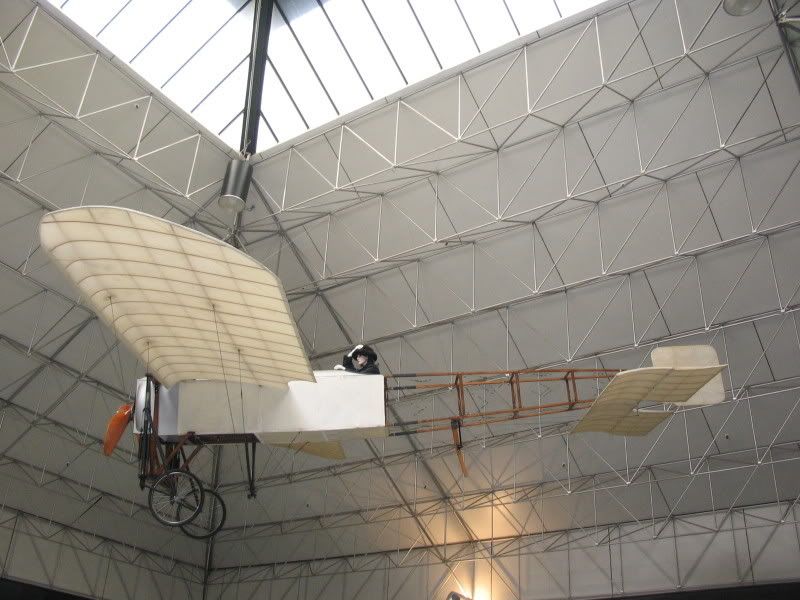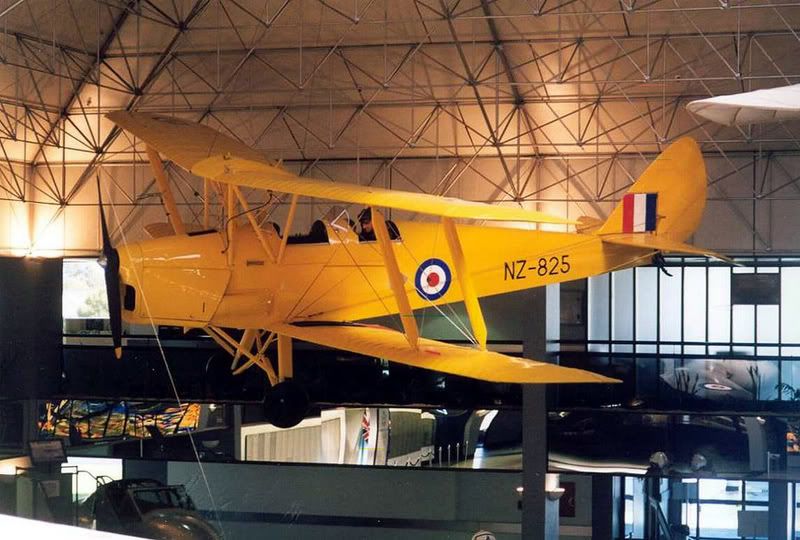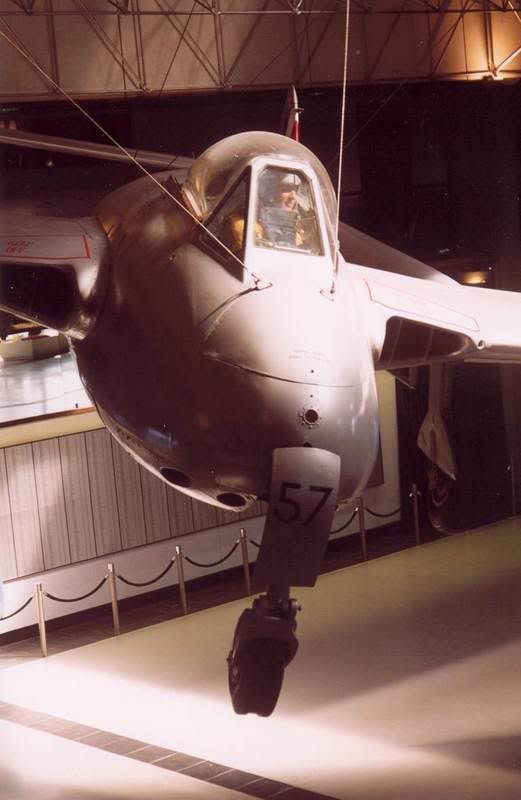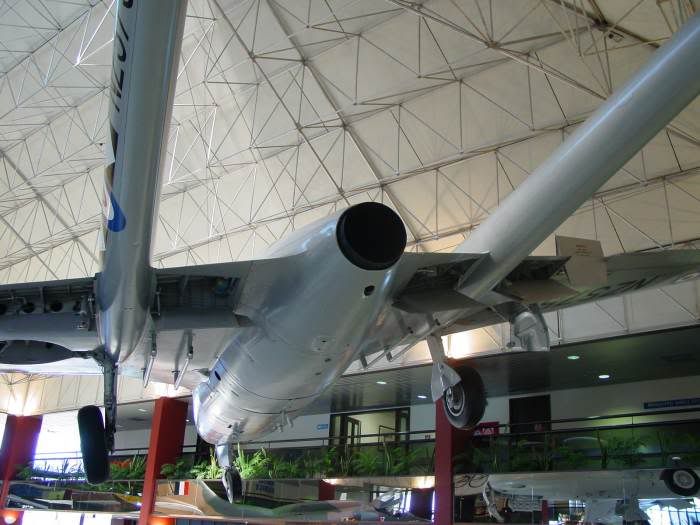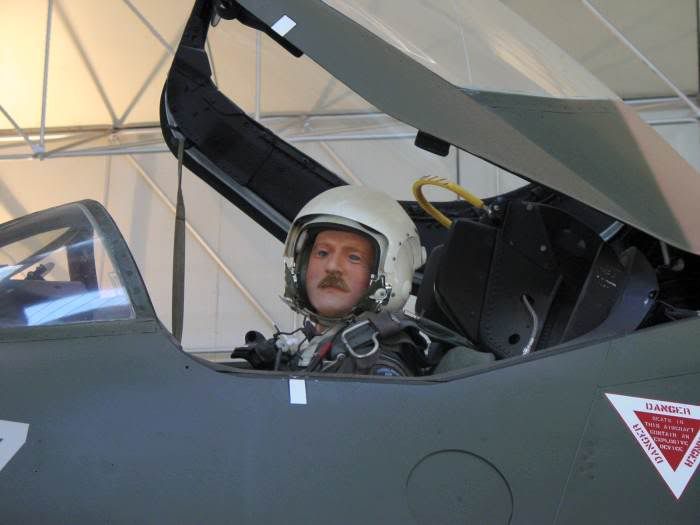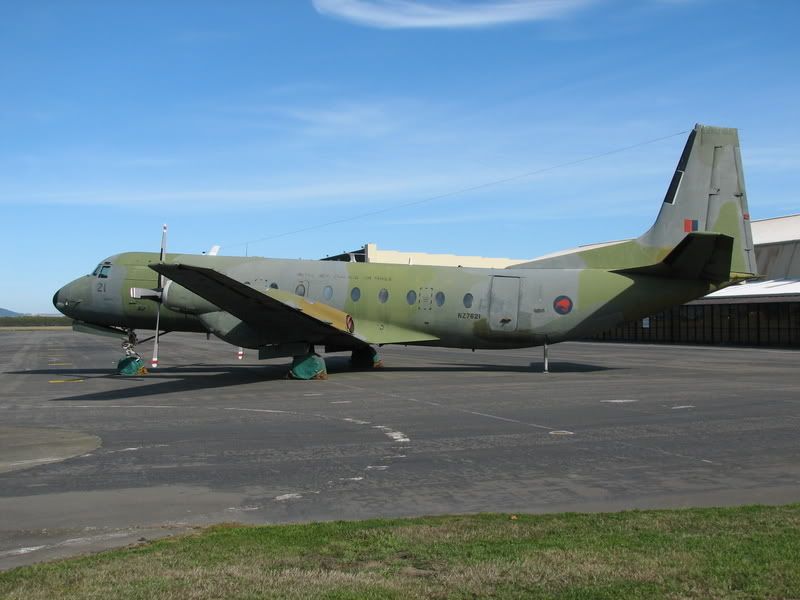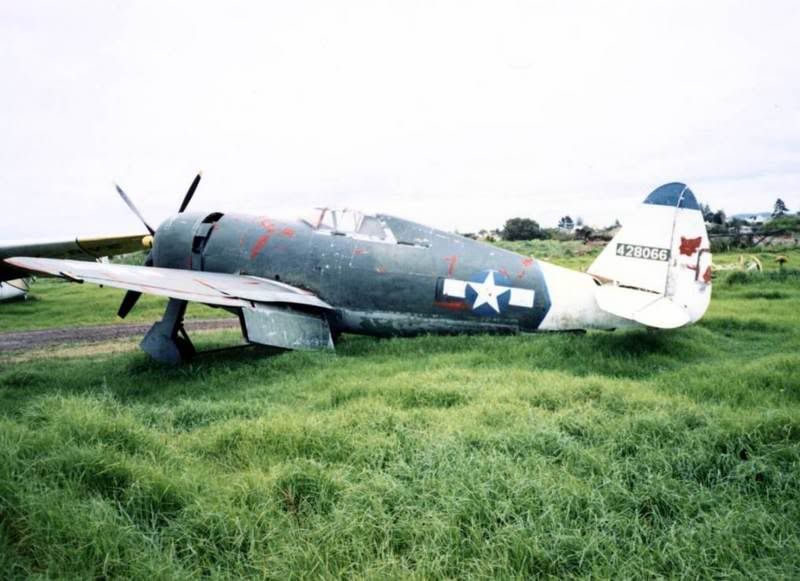
Royal New Zealand Air Force Museum

The RNZAF Museum Aircraft Collection
In the Atrium Hall Bleriot XI-2 "Britannia" Replica
In the Air New Zealand Aircraft Hall
(No. 1 Hangar)In No. 3 Hangar Displayed Outdoors Under Restoration In Storage RNZAF Museum Aircraft Out on Loan de Havilland Vampire
Former RNZAF Museum Aircraft Aircraft Formerly on Loan to RNZAF Museum Aircraft Almost Bought or Built By RNZAF Museum RNZAF Museum Restoration Bits Where-Are-They-Now RNZAF Museum Aircraft
Bleriot XI-2 "Britannia"
ReplicaThe replica Bleriot was built by the late Dave Comries in his back yard in Dunedin, who was ably assisted by Colin Hay. Comries began the project in 1985, and during construction he found that they were actually not building the correct military version, so changes had to be hastily made to get it right. It was completed on time though, just (with finishing touches and fitting of the engine taking place in the RNZAF Museum just before it was hung). And since the opening of the RNZAF Museum's main building on the 1st of April 1987, it has been displayed with pride of place in the Atrium. It hangs from the Atrium ceiling as if in flight and can be viewed also at eye level from the mezzanine floor. The 80hp Gnome engine is actually a wooden replica, and was constructed by Les Heath.
The aircraft represents the Bleriot XI-2 Monoplane that was donated to the New Zealand Government by the Imperial Air Fleet Committee in England to help this country to pursue military aviation. The original Bleriot arrived in New Zealand in September 1913, but was not flown till January 1914.
It was flown by 2nd Lt Joe Hammond, a New Zealander who had learned to fly in Britain with the RFC and who became New Zealand's first military pilot. With the Bleriot he made a small number of test flights from Epsom Showgrounds, Auckland, before being ready to take a passenger aloft. But rather than selecting one of the dignitaries present to become his first passenger, Hammond chose instead Miss Esme McLennan of the Royal Pantomime Company. This caused embarrassment to the officials and Hammond was fired. The aircraft put into storage and eventually returned to the UK in October 1914 with the first Echelon of the NZEF who were going off to WWI. The Bleriot went on to contribute to the Empire's war effort, but what became of it is not known.
The replica is very realistic, and features a replica of Joe Hammond at the controls too. In more recent years an addition to the aircraft has been the dummy passenger, depicting a well dressed Edwardian woman, Joe's famous passenger, Esme.
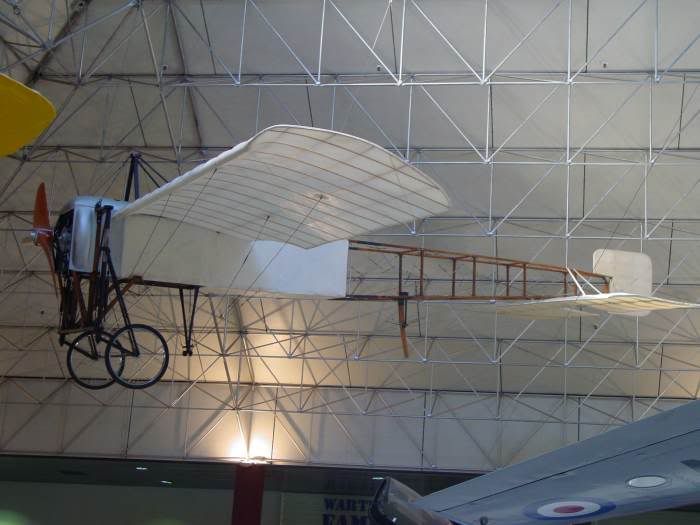
Above: Photo copyright Dave Homewood
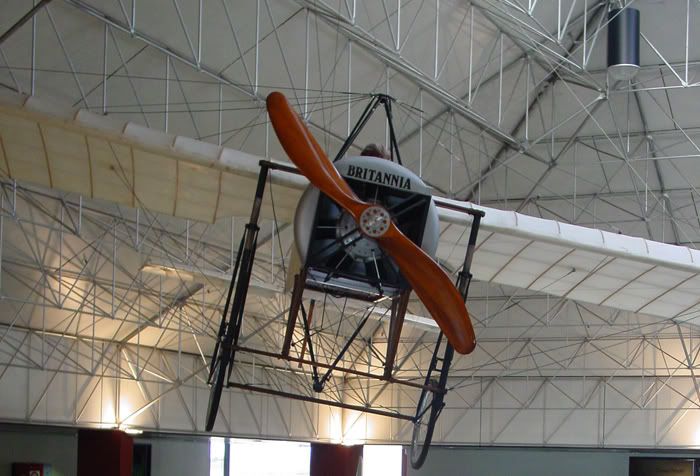
Above: Photo copyright Dave Homewood
Above: Photo copyright Craig Brankin
The photo above, kindly supplied by Craig Brankin, shows to great affect the passenger that was added
in more recent years to this display.
de Havilland DH82 Tiger Moth
NZ1481 (as NZ825)This genuine RNZAF Tiger Moth was built in New Zealand at the Rongotai-based de Havilland New Zealand factory. It served in the RNZAF as NZ1481, but wears the colour scheme of NZ825.
This Tiger was brought on charge by Unit 39 at RNZAF Station Rongotai on the 25th of January 1944. It then served with No.2 Elementary Flying Training School, at RNZAF Station Ashburton. When Ashburton was closed it moved to No.1 EFTS, at RNZAF Station Taieri.
Postwar went to No. 1 Technical Training School at RNZAF Station Hobsonville, moving there from Taieri in September 1946 and operated first as a serviceable aircraft until being converted to become an instructional airframe. it was given the serial INST150 with TTS Hobsonville on the 11th of November 1951, this ceasing to be an aircraft any more.
In 1956 the Tiger Moth was moved to the Invercargill Air Training Corp i where it was converted into a Link Training aid. It then went to No. 4TTS at RNZAF Woodbourne until 1969. It is believed to have been stored at Aerospace Industries in Hamilton for some time. It eventually made its way back to the RNZAF, joining the RNZAF Museum collection in March 1987 where it is now displayed as NZ825.
The aircraft was refurbished by the voluntary group known as The Moth Doctors, who got their name because when the section was formed there was a shortage of overalls at the museum for them, so they were given white coats. This team was made up of Bob Swadel, Jim Williams, Jim Grant (a former RNZAF engineering officer), Vic Braggins, Ian Tilson (a former RNZAF pilot and later military dentist) and none other than the late fighter pilot Wing Commander Johnny Checketts.
The Moth Doctors apparently restored this aircraft, beginning the project in 1984, but when completed some time afterwards they were given the task of restoring two more Tiger Moths to fly, one of which went onto and continues to fly with the RNZAF Historic Flight, now at Ohakea. So some parts from the original restoration were removed from this aircraft for the airworthy restorations before it went on to be displayed hanging in the Atrium. Today it represents the 335 Tiger Moths that served with the RNZAF from 1939 till 1956.
Incidentally the aircraft it is painted as, NZ825, was also built at Rongotai, and brought on charge by Unit 18 at RNZAF Station Rongotai on the 25th of June 1941. It served with, at least, No. 42 Squadron, which was the RNZAF's main communications squadron during the war.
On the 11th of January 1946 the real NZ825 was gifted free to the Middle Districts Aero Club and it entered the New Zealand Civil Aircraft Register as ZK-AIB. It then became a topdresser with W. Bower and Company in January 1954 but it crashed after stalling in a turn at Putara on the 17th of May 1954 and was not rebuilt. It then passed to Aviation Sales and Service, then onto the Hawera Aero Club in June 1957.
Again it went to Aircraft Sales and Service, Palmerston North in June 1958. The fuselage was stored at Kairanga in 1961. The aircraft was cancelled from register on the 2nd of November 1962, as the aircraft was dismantled. Ownership had passed to Colin Smith of Gore by 1980. It was then restored to the civil register the 5th of June 1987 with C. Smith, Gore. It was cancelled from the register on the 31st of August 2001 as withdrawn. However it's believed to be under restoration at Colin Smith's Croydon Aircraft Company facility at Mandeville.
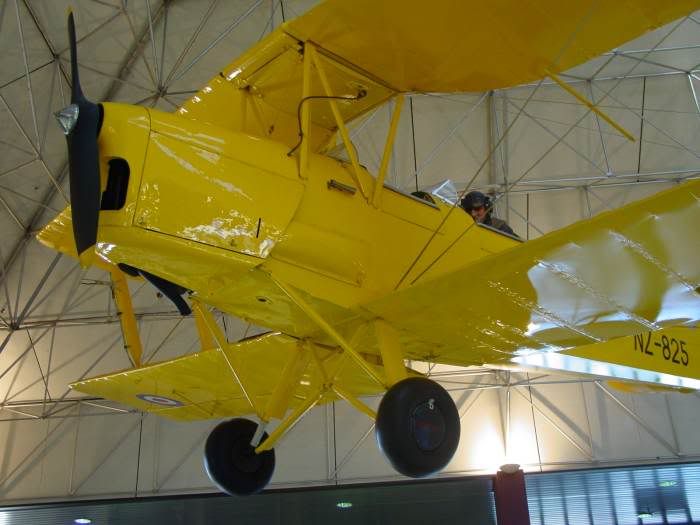
Above: Photo copyright Dave Homewood
Above: Photo copyright Dave Homewood
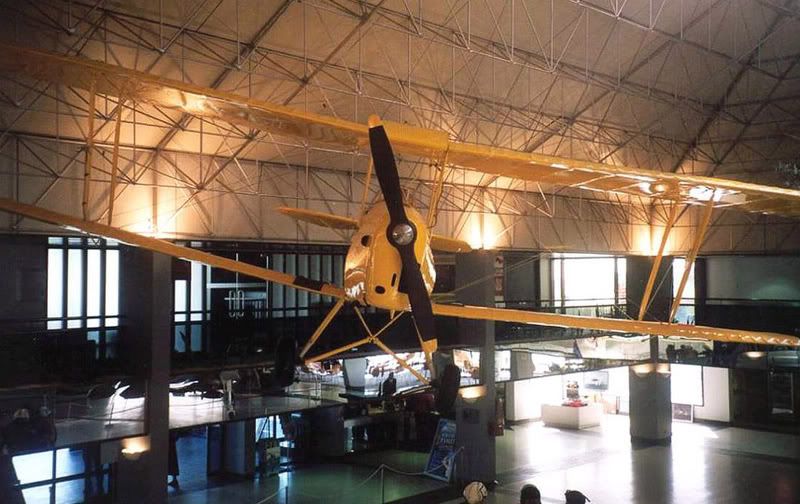
Above: Photo copyright Dave Homewood
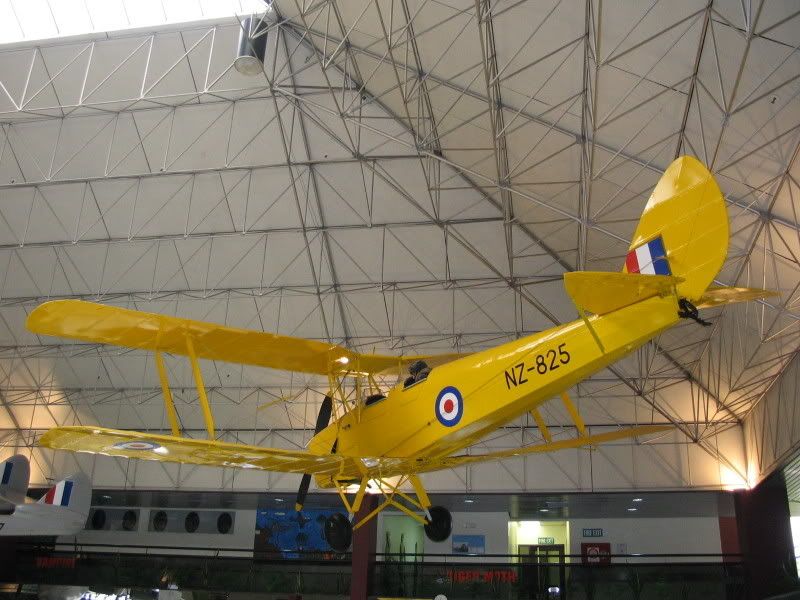
Above: Photo copyright Craig Brankin
de Havilland Vampire FB5
NZ5757Vampire FB5 NZ5757 originally saw service with the Royal Air Force as WA311, having been delivered to the RAF on the 21st of January 1951 and allocated to No.93 Squadron. It was struck off charge from the RAF on the 20th of May 1953.
It was then shipped to New Zealand aboard the "Hororata", and brought on charge with the RNZAF as NZ5757 on the 12th of September 1953. The aircraft served with It served with No 75 Squadron, the Fighter Operational Conversion Unit, and the Jet Conversion Unit at Ohakea between 1953 and 1960. It then went into long term storage.
NZ5757 was then converted to an instructional airframe, numbered INST193, with No. 4TTS at Woodbourne on the 5th of April 1964. In 1965 the airframe was given to the Central Institute of Technology in Petone. However it was not delivered to them till 1972. In 1978 it was donated back to the RNZAF when moves were afoot to start a museum at Wigram. It joined the RNZAF Museum collection subsequently, and after being prepared by personnel at RNZAF Station Ohakea, went on display in the Atrium in 1987, ready for the official opening of the new museum buildings. It remains hanging on display in the Atrium. It wears No. 14 Squadron, RNZAF colours, one of the few Vampire units it did not appear to serve with in the RNZAF.
Above: Photo copyright Dave Homewood
Above: Photo copyright Dave Homewood
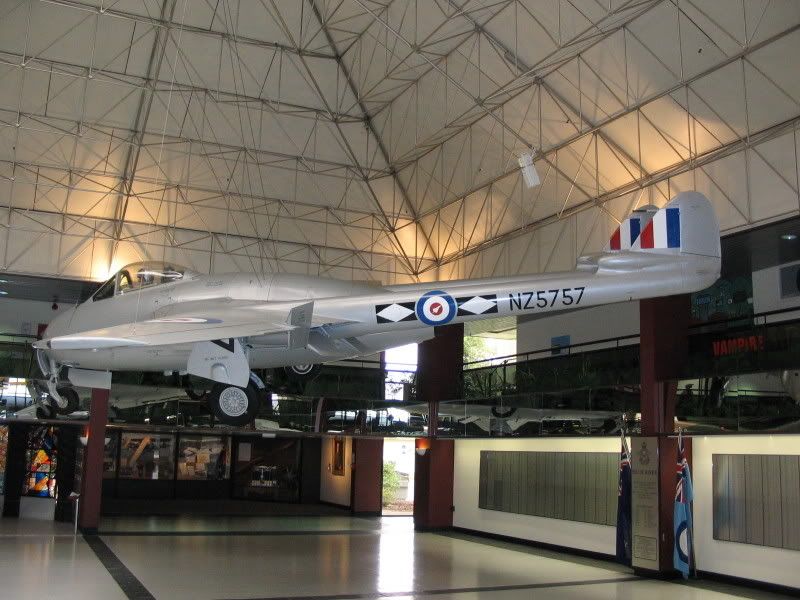
Above: Photo copyright Craig Brankin
The photo above, kindly supplied by Craig Brankin, shows clearly the markings worn by the No. 14 Squadron
Vampire. Note the short-lived roundel with the white fern.
McDonnell Douglas A-4K Skyhawk
Replica of NZ6207Posing admirably as RNZAF Skyhawk NZ6207, this aircraft was officially dedicated and handed over to the RNZAF Museum in a ceremony on the 8th of November 1988. It had been donated by McDonnell-Douglas Corporation prior to this date and had been restored by the RNZAF Museum team under Sqn Ldr Sandy Currie.
This Skyhawk had been built as an A-4C (some sources state A-4D-2N) model for the US Navy, and later modified to an A-4L status. It's real identity being c/n 61-0022, BuNo.149516.
After serving with the US Navy for an extended period, it then went to Flight Systems Inc. which operated it for military work from Mojave, north of Los Angeles. It was acquired from the Davis Monthan Air Recovery Centre by the US Navy and McDonnell-Douglas who donated it on long-term loan to the museum, and it arrived at Wigram in a Hercules at 13.45hrs on the 27th of January 1988.
Between then and November 1988 the airframe was rebuilt and upgraded to A-4K status (pre-Kahu), which involved extensive planning, stripping and overhaul. The two models of Skyhawk were vastly different, the A-4L having the less powerful J-65 engine compared with the A-4K's J-52 being just one difference. Additional hardpoints were added, intakes changed, a new tailfin, rudder modified, a parachute brake housing added and finally the cockpit rebuilt to A-4K kit.
Once completely transformed into a Kiwi Skyhawk, it was painted to represent NZ6207, as it was in 1974 when it became the first Skyhawk to be lost in RNZAF service shortly after take-off at Ohakea. The original crashed on the 18th of October 1974, into a paddock near Bulls when it suffered an engine failure in the Ohakea circuit. Wing Commander Fred Kinvig ejected but broke his leg on landing. The aircraft was written off the books at Ohakea on the 17th of March 1976.
Due to weight loading on the Museum's Atrium floor, the J-52 engine was not fitted to the Skyhawk, and underwing armaments seen suspended from the attack aircraft are in fact fibreglass replicas.
Among those present a t the official handing over of the Skyhawk were Air Marshall Sir Richard Bolt (Chairman of the Board of Trustees of the RNZAF Museum), Group Captain Graham Goldsmith (Wigram Base Commander), Mr A. Patten (McDonnell-Douglas Australasian Representative), Squadron Leader W.A.K. "Sandy" Currie (RNZAF Museum Technical Officer), Squadron Leader John Barry (RNZAF Museum Director), Charles "Pete" Conrad (former Apollo 12 lunar astronaut) and Flight Sergeant Alan Woodley (RNZAF Museum Aircraft Restoration Team) .
Above: Photo copyright Dave Homewood
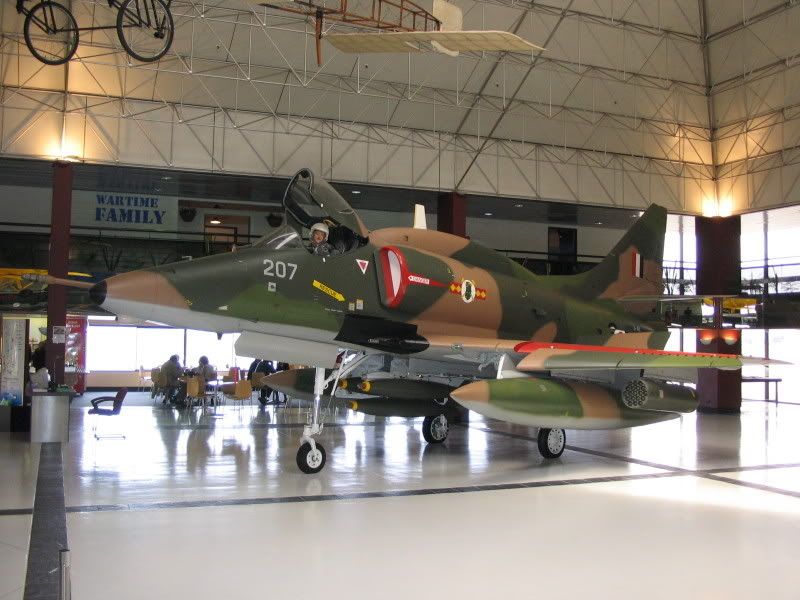
Above: Photo copyright Craig Brankin
Above: Photo copyright Dave Homewood
A little bit of trivia is all the mannequins in the RNZAF Museum have been moulded from real faces, those of genuine airmen and airwomen who have served at Wigram. The Skyhawk pilot seen above is moulded from Corporal John Harris, the Safety and Surface Technician who made all the mannequins.
de Havilland Vampire Cockpit
NZ5767NZ5767 was previously WA374 with the RAF, serving from the 11th of April 1951 with No. 102 Flying Refresher School, then No's 118 and 14 Squadrons, till it was struck off charge on the 26th of March 1956. It was another second hand attrition airframe bought by the RNZAF, and was shipped to New Zealand aboard "Cumberland".
It was brought on charge with the RNZAF on the 21st of May 1956. It went into storage at Ohakea from September 1956, and then served with various units from January 1958. Stored again from March 1960, this time at Woodbourne, NZ5767 then joined No. 75 Squadron in October 1963. The aircraft transferred to No. 14 Squadron in May 1970.
It was then converted into an instructional airframe, becoming INST202 at No.4 TTS Woodbourne on the 21st of August 1970. Subsequently it went to the RNZAF Museum collection. The fuselage of NZ5767 is presently on display in the Atrium with steps so people can observe, and even sit in, the fighter's cockpit.
(No. 1 Hangar)
Above: Photo copyright Glenn Alderton
North American Harvard IIA
NZ1050The Harvard which can be seen at the entrance gate to former RNZAF Base Wigram, and that now acts as gate guard for the RNZAF Museum, is NZ1050. This aircraft was shipped to New Zealand onboard the "B.J. Wheeler" in July 1943 and was assembled at RNZAF Station Hobsonville.
It was Brought on Charge on the 19th of July 1943. It served with No.2 (Fighter) Operational Training Unit, at RNZAF Ohakea. It became the twenty fifth Mk IIA to be converted to Mk 2A* sometime between August 1954 and May 1957. After serving at Wigram as a trainer, it was then stored at Woodbourne from September 1972. The aircraft was converted to become instructional airframe INST207 on the 20th of February 1973.
However money was raised by an Air Force veterans group who wished o mark the 50th Anniversary of the establishment of the New Zealand Permanent Air Force in 1923. So the Harvard was chosen to be repainted as NZ1050with the funds raised into the overall yellow training colours, with "050" in large red numerals on the sides. It was then transported to Wigram to be mounted as the gate guard, and was unveiled officially on the 50th Anniversary of military aviation in this country, on the 14th of June 1973.
There was at least one more repaint in the yellow scheme, where the markings changed so that the "050" was gone and replaced by the call sign '21' in black. A blue band was also added to the fuselage denoting the particular flight that aircraft would have served in.
In 1993 when flying training was to cease at Wigram, and thus the technical staff were to be withdrawn to other bases, it was decided to repaint the Harvard again before the Safety and Surface Workers had all gone. So in early April 1993 the aircraft was carefully lifted down from its plinth by carne, the wheels were lowered by Technical Squadron staff, and it was wheeled down to No. 6 Hangar where it awaited repainting. Beside it in the hangar was another WWII veteran being repainted by the same S&S team, Sir Tim Wallis's TBM Avenger which was being put into RNZAF colours.
Once the Avenger had gone from the hangar, the Harvard was begun. By this time the powers that be had decided that with the closure of the base flying, a special tribute to the many decades of postwar flying by both Harvards and Airtrainers would be made. So instead of a new coat of wartime yellow paint, the Harvard was repainted in the familiar postwar Dove Grey and International Orange scheme that had graced Wigram's skies since the 1960's. When the newly refreshed Harvard was once again hoisted onto its pole at the gate, now in lovely glossy paint, it made the local television news.
Since that time after the base's closure the gate entrance has been redesigned - with the loss of a lot of the land around it to housing - so the Harvard has actually moved from the left side when entering the gate to the right side, which is probably more prominent for motorists coming from the city. I believe it may have been painted again since in the same scheme - either that or the paint job we did in 1993 is holding up remarkable well.
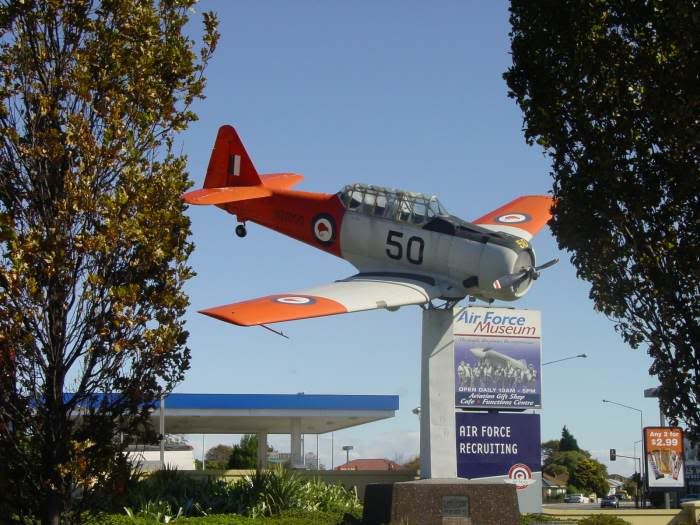
Above: Photo copyright Dave Homewood
Above, NZ1050 photographed by Dave Homewood in April 2006, and below the same gate guard again and in the same year, this time from Craig Brankin's camera

Above: Photo copyright Craig Brankin
Hawker Siddeley Andover CC Mk 1
NZ7621
Above: Photo copyright Craig Brankin
The Andover sits outdoors on the tarmac apron next to No. 1 Hangar
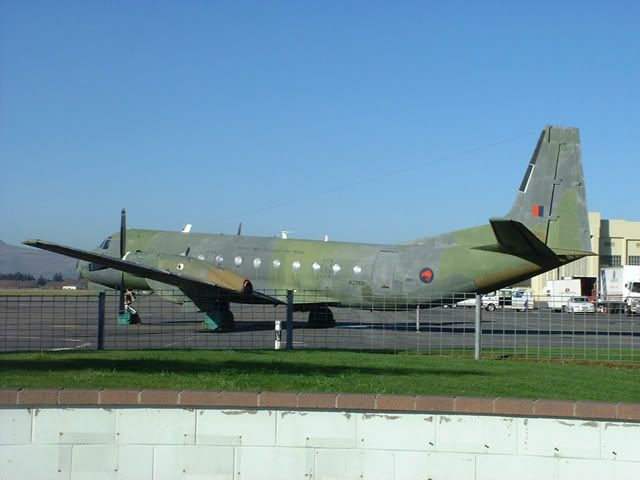
Above: Photo copyright Marcus Bridle
(No. 2 Hangar)
Airspeed Oxford
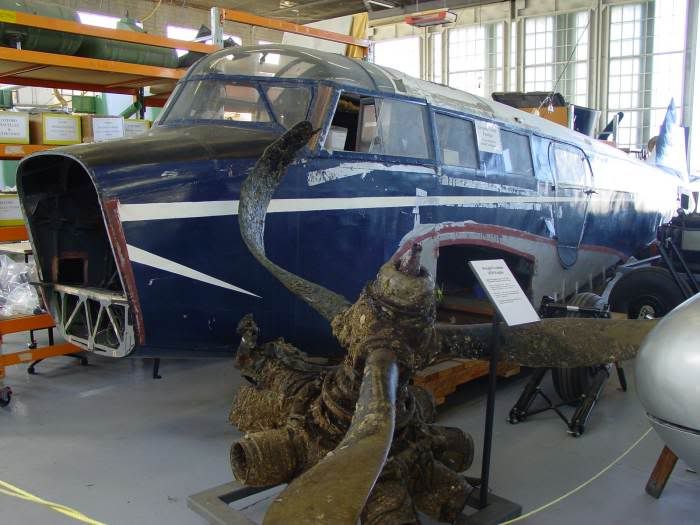
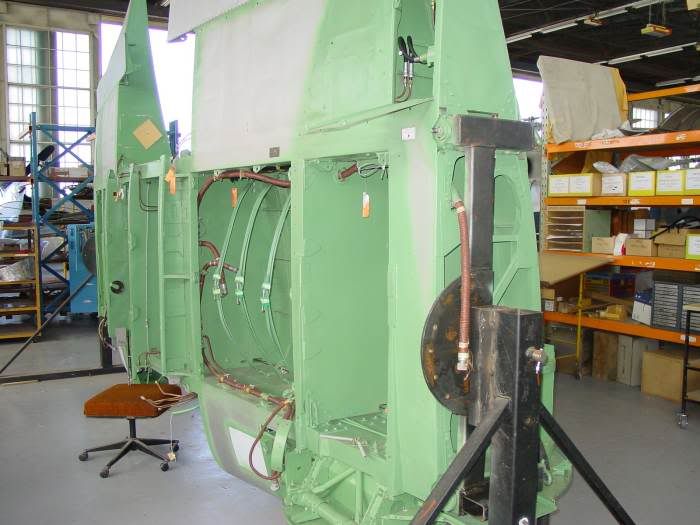
Above: Oxford photos copyright Dave Homewood
Vickers Vildebeest
NZ102
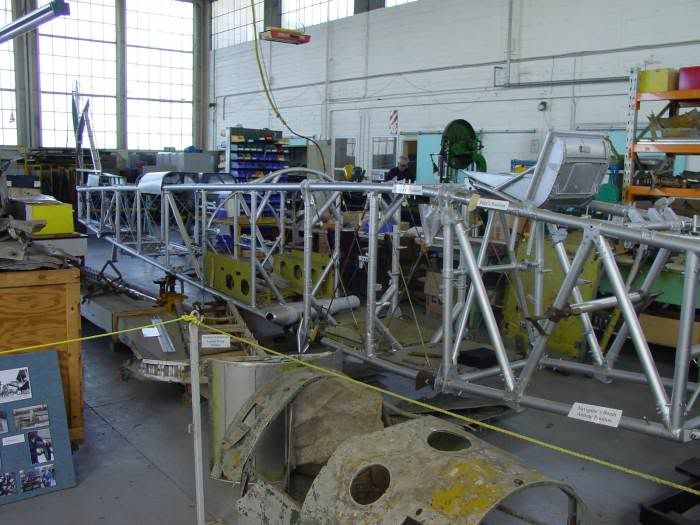

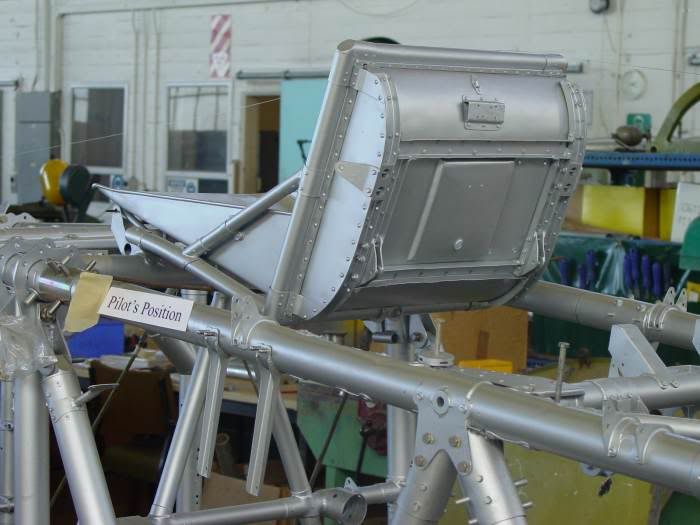
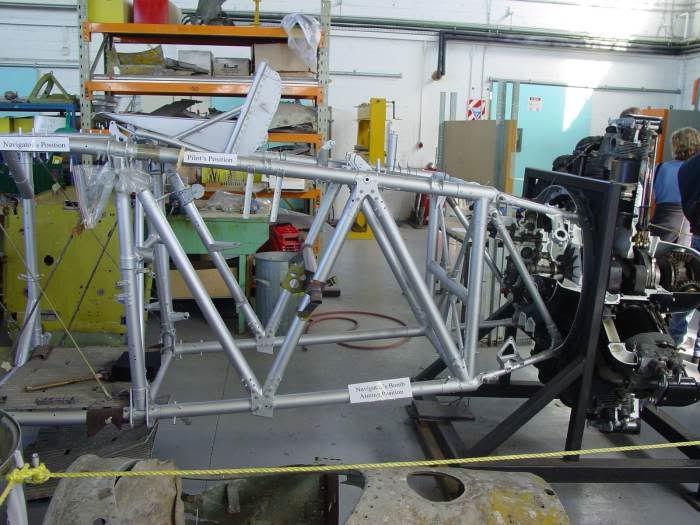
Above: Vildebeest photos copyright Dave Homewood
Curtiss P-40E Kittyhawk
Replica of NZ3024
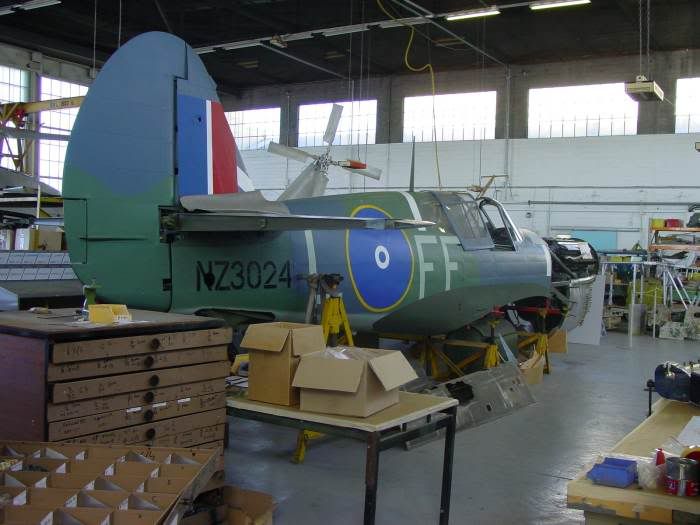
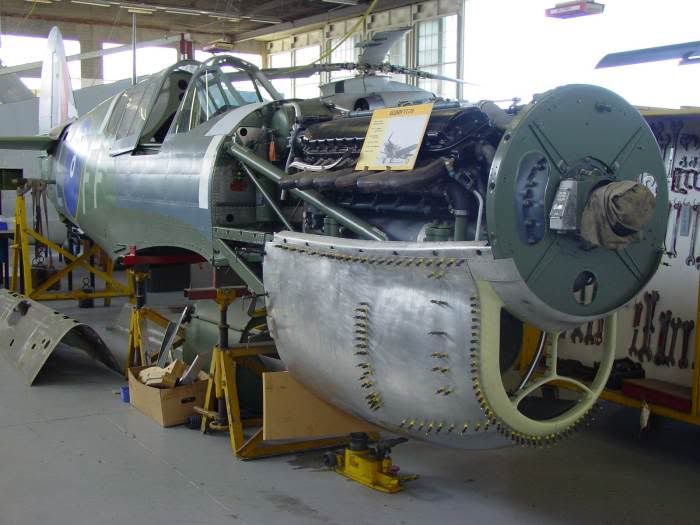
Above: P-40E photos copyright Dave Homewood
In Storage
Douglas Dauntless
NZ5037
RNZAF Museum Aircraft Out On Loan
TBF-1 Avenger
NZ2505
Former RNZAF Museum Aircraft
Bristol Freighter
Chance Vought F4U-5N Corsair
Republic P-47D Thunderbolt
The Republic P-47D Thunderbolt arrived at the Museum in 1993, and left in 1995. Having little connection to RNZAF history, this aircraft had been gifted to the RNZAF Museum in 1993 by the Museum of Transport and Technology in Auckland. It was intended to be used as a swap item so the RNZAF Museum could gain something more relevant, and it was.
In poor condition when it arrived at Wigram, the Thunderbolt, or 'Jug' as they were affectionately known, would have proven too big a job for proper restoration for MOTAT, and the expense and time in such a venture not worth it for the RNZAF Museum.
This aircraft, serial number 42-8066, began life in 1942 and went into service in the Pacific Theatre. It was assigned to William Otto Carter Jr. who flew it during September and October 1943.
On the 1st of October 1943 Carter flew a morning mission in the aircraft. Later that same day, another pilot, Wallace Harding used the aircraft. During the flight the oil pump failed and the engine seized.
Harding made a wheels-up landing in the Waigani swamp, north-east of Port Moresby, New Guinea. The wreckage remained there until 1967. At that point the Air Museum of Papua New Guinea recovered the Thunderbolt wreck. More detail of the recovery can be found here, but basically the Museum attempted restoration on the airframe but little was done, and it sat around for a length of time. Then the Museum of Transport and Technology in Auckland, New Zealand, struck a deal and the remains were shipped to New Zealand in about 1970-1972.
MOTAT attempted to rebuild it, but a lot of the structure wasn't present, and I noted when it got to Wigram that a lot of the repair work they did seemed to involve plywood and fibreglass. For some time the "Jug" sat in the open near the entrance gate to Keith Park Memorial Airfield (MOTAT 2). It was eventually gifted to the RNZAF Museum in exchange for a magnificent restoration job done by the RNZAF Museum's workshop on restoring MOTAT's Mosquito wing.
When the Sopwith Pup deal was struck as a swap for the Thunderbolt, it went to Australia, where Rob Greinert's team are currently rebuilding it to fly. So after many sad years of neglect, a great result should soon be seen with another Thunderbolt airborne. This was the oldest existing P-47D still extant till Greinert dug up another and recovered it from the Pacific war zone which was slightly older still. He apparently has three Thunderbolts that are undergoing restoration.
Above: Photo copyright Dave Homewood
Above: The Thunderbolt as photographed by me whilst still at MOTAT in the late 1980's.
The condition when it arrived at Wigram was similarde Havilland Vampire T.11
NZ5708This aircraft was transferred to the RNZAF on the 18th of October 1955 from RAF stocks. It was shipped to New Zealand aboard the SS Hororata, and brought on charge with the RNZAF on the 16th of December 1955.
Following service at Ohakea, it took part in the New Zealand-wide farewell tour to the Vampire type in November 1972. It was then flown to RNZAF Base Woodbourne on the 15th of December 1972. It was converted to an instructional airframe as INST204 with No. 4 Technical Training School at Woodbourne on the 26th of January 1973.
Eventually the Vampire was transferred to the RNZAF Museum at Wigram in March 1984. A deal was struck with the Indonesian Air Force to exchange the Vampire for a F-51D Mustang in April 1985. It went to Indonesia and went on display at the Indonesian Air Force Museum in Yogyakarta, marked "J-701" and in full Indonesian markings.
North American Harvard Mk IIA
NZ1034This Harvard was used by the RNZAF Museum as a swap item and was gifted to the RAAF Museum at Point Cook, Australia, in exchange for the ex-RAAF Canberra B.20 now on display in the RNZAF Museum's Air New Zealand Aircraft Hall.
This aircraft originally arrived in New Zealand aboard "Vessel 27" in April 1943. it was assembled at RNZAF Station Hobsonville and brought on charge on the 20th of April 1943. It's initial service isn't known to me but it was with the Central Flying School of the RNZAF, based at RNZAF Tauranga, in early 1944. The Harvard then served with No.2 (Fighter) Operational Training Unit at RBZAF Ohakea later in 1944 and into 1945.
Postwar NZ1034 served with No.4 (TAF) Squadron at RNZAF Taieri from the 2nd of November 1950 till the 8 October 1951. At this point it moved north to join No.3 (TAF) Squadron at Wigram, and served with that squadron till the 7th of July 1952.
Between August 1954 and May 1957 this Harvard was converted from a Mk IIA to a Mk 2A* model. It served then at Wigram in the training role, and was stored at Woodbourne from August 1972.
Withdrawn from use, NZ1034 was converted to INST210 - an instructional airframe with No. 4TTS Woodbourne in 1976. it was then transferred to Ohakea. The Harvard was issued to the RNZAF Museum Ohakea Wing in August 1977 in complete but unflyable condition.
The aircraft was displayed by the Ohakea Museum in the camouflage colours it wore whilst flying with No. 2 (F) OTU at Ohakea.
In 1982 a deal was done in which NZ1034 was swapped to the RAAF Museum at Point Cook, and the RAAF presented the RNZAF Museum with a GAF Canberra in return. The Harvard was refurbished at ohakea by a team of RNZAF regulars, and finished in the yellow training colour scheme of NZ947, which had been based during the war with No. 2 Service Flying Training School at Woodbourne.
NZ1034 in new guise was finally flown to Australia inside an RNZAF Hercules for presentation to the RAAF Museum on the 12th of December 1988. it is now on display in Point Cook's museum.
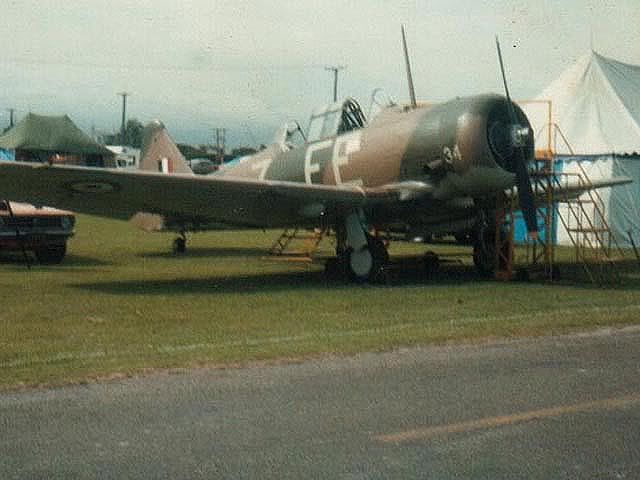
Above: Photo copyright Marcus Bridle
Above: This is NZ1034 whilst at Ohakea and in the colours of No. 2 OTU. Thanks to
Marcus Bridle for the photograph
Aircraft Formerly On Loan To the RNZAF Museum
Miles Whitney Straight
Percival Proctor V
Hawker Hind
NZ1544Porterfield 35W
NZ581Fokker DR.1 Triplane
Fokker F-27 Friendship
Aircraft Almost Bought or Built By RNZAF Museum
de Havilland Puss Moth
Caudron Replica
Bristol Fighter Replica
RNZAF Museum Aircraft Bits Collections
Lockheed Hudson Fuselage
NZ2084?Airspeed Oxford Parts Collection
NZ1229, NZ1289, and NZ1302Mosquito Parts Collection
NZ2355
Where-Are-They-Now RNZAF Museum Aircraft
Rhonlerche Glider
BQ
